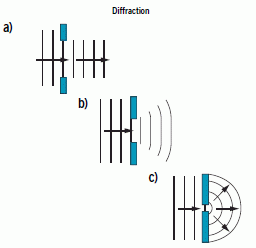Wave Behaviour
Reflection
All waves can be reflected, but this does not prove they are waves because particles also show these effects. According to the law of reflection, the angle of incidence equals the angle of reflection. This can be shown on a wave diagram or a ray diagram. Echoes are reflections of sound waves from hard surfaces.

This video explains about the angle of incidence, angle of relflection and reflection of light
Refraction
When waves enter a different medium they change speed. The wavelength changes, but the frequency stays the same. They change direction unless they are travelling along the normal to the boundary. This is called refraction.
As light waves enter a denser medium they slow down and bend towards the normal. As light waves enter a less dense medium they speed up and bend away from the normal. Water waves slow down as they go from deep water to shallow water.


The angles of incidence, reflection and refraction are all measured to the normal, not to the surface. Draw the normal at right angles to the surface.
This video explains about the refraction of light.
Diffraction
Diffraction is the spreading out of a wave when it passes through a gap. The effect is most noticeable when the gap is the same size as the wavelength. Particles cannot be diffracted. So diffraction is good evidence for a wave.

The wavelength of sound waves is about a metre, so when sound waves are diffracted through doorways people can hear round corners.
Water waves are sometimes diffracted by harbour entrances.
The wavelength of light is about half of a millionth of a metre – so small that diffraction effects are only noticeable when light waves pass through gaps of about a hair’s width. Larger gaps have shadows with sharp edges. This is one reason why it took so long for scientists to realise that light can behave as a wave.
